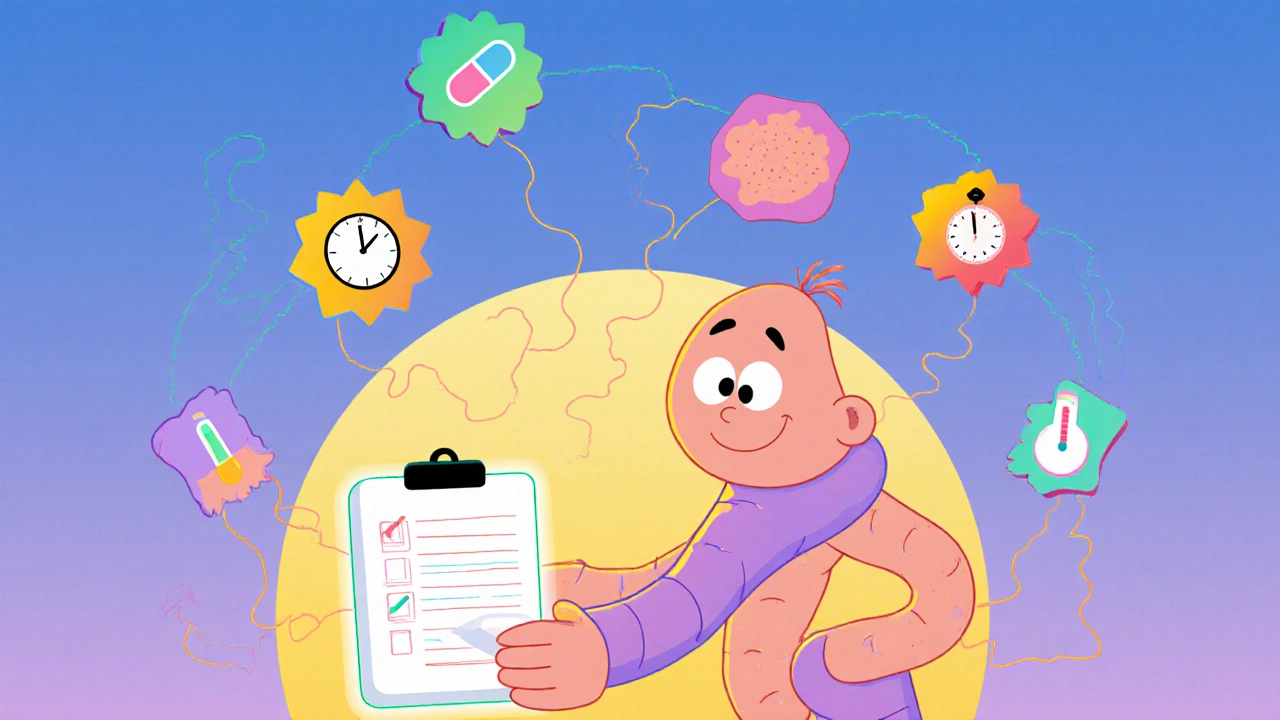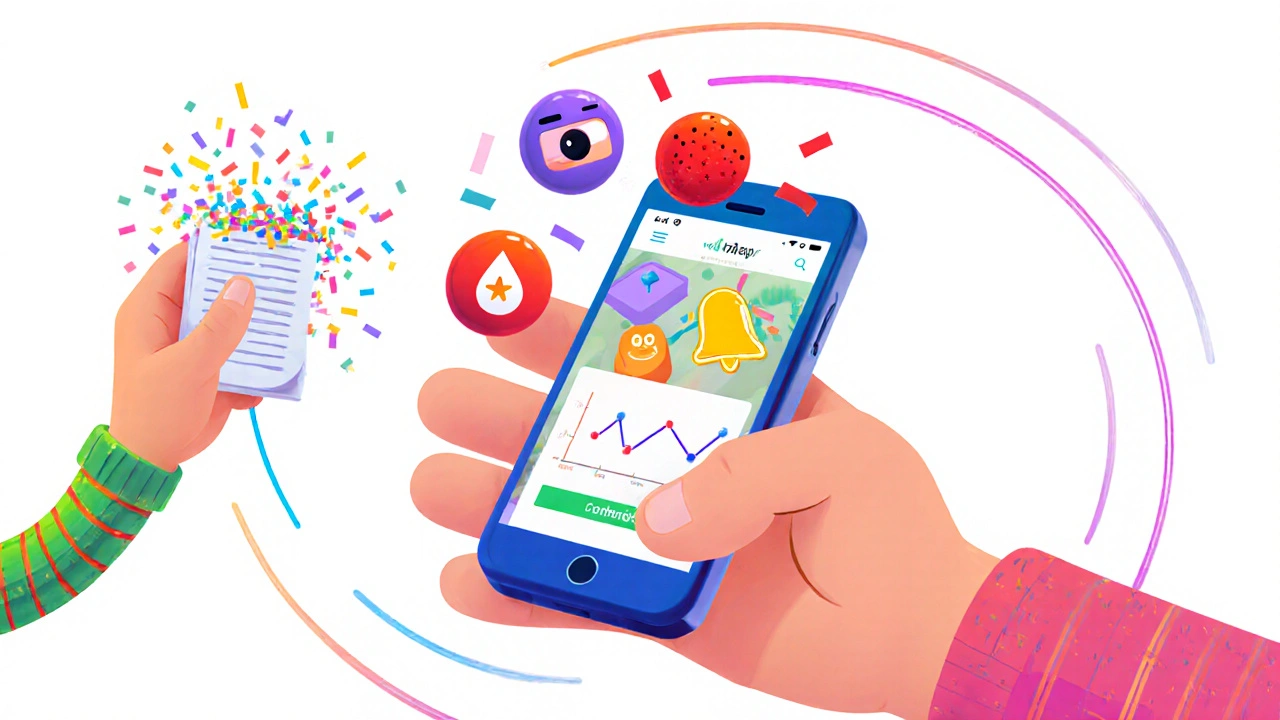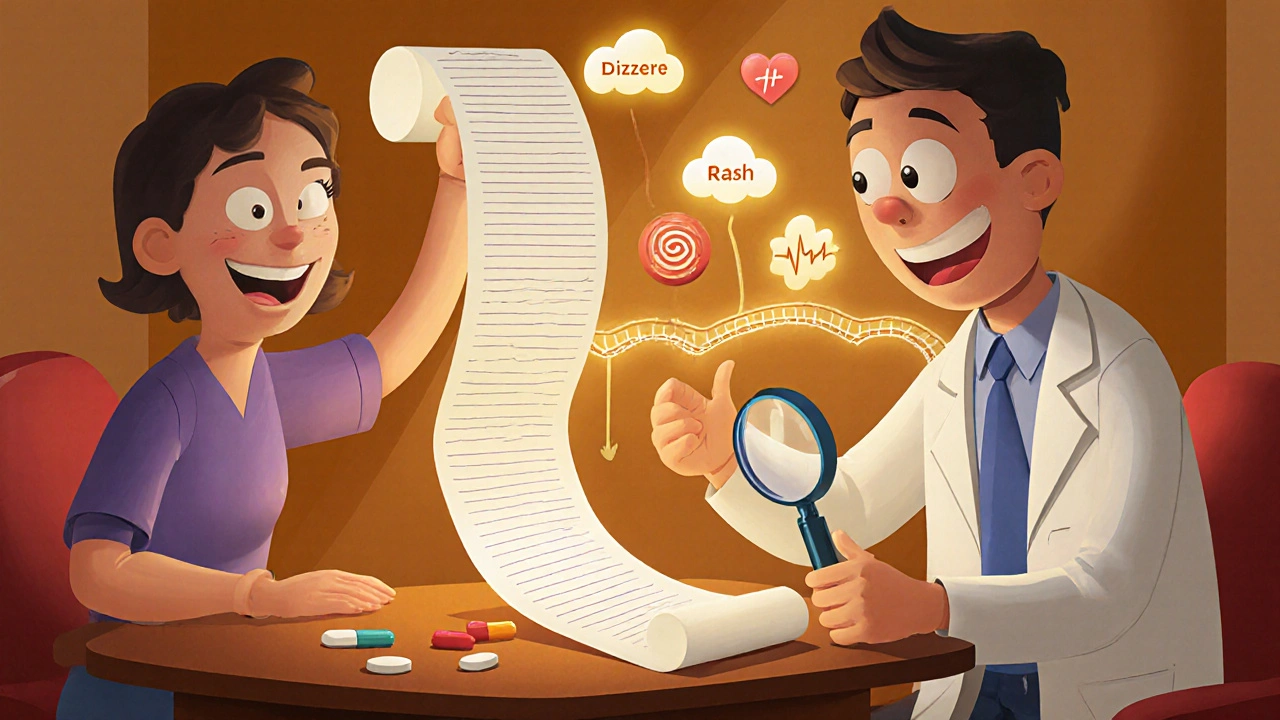
When you start a new medication, you might notice something off - a headache that won’t quit, a rash that appeared out of nowhere, or dizziness that hits right after you take your pill. But is it the drug? Or is it just stress, lack of sleep, or something else? Without a clear record, it’s easy to miss the connection. That’s where a symptom diary comes in. It’s not just a notebook. It’s your best tool to figure out if a drug is causing real problems - and to help your doctor make faster, smarter decisions.
Why a Symptom Diary Matters
Most people don’t realize how unreliable memory is when it comes to side effects. A study from the National Institute on Aging found that after 48 hours, people forget key details about when symptoms started, how bad they were, and what they were doing at the time. That’s a problem because doctors need to know if a symptom showed up 30 minutes after taking a pill - or three hours later. The timing tells them if it’s likely linked to the drug. A 2023 FDA safety report showed that patients who kept detailed symptom diaries reduced false reports of side effects by 62%. That means fewer unnecessary drug changes, fewer misdiagnoses, and less time wasted guessing. One patient on Reddit shared how their neurologist dismissed their dizziness until they showed a 14-day log that clearly tied it to their levodopa doses. Within two days, their dosage was adjusted. That’s the power of data.What to Track: The 9 Essential Details
Not every note counts. The FDA and NIH agree: your diary needs nine specific pieces of information to be useful. Skip any of these, and your log becomes just a journal - not a medical tool.- Date and time of medication intake - down to the minute. Don’t write “morning.” Write “8:15 a.m.”
- Exact dosage and route - “50 mg tablet by mouth,” not “my pill.”
- All other medications and supplements - including aspirin, melatonin, or that turmeric capsule you take. Drug interactions are common and often hidden.
- Exact symptom description - “Nausea” isn’t enough. Was it a queasy feeling? Did you vomit? Where did it start - your stomach, throat, head?
- Time symptom started - How long after taking the drug? 10 minutes? 6 hours? Write it.
- How long it lasted - Did it fade in an hour? Last all day? Keep going?
- Environmental factors - Were you stressed? Hot? Exercising? Sleeping? These can mimic or worsen side effects.
- What you did to fix it - Did you lie down? Take antacids? Drink water? Note it.
- How it ended - Did it resolve on its own? Did something help? Did it get worse?
Severity matters too. Use the Common Terminology Criteria for Adverse Events (CTCAE) scale: Grade 1 is mild (annoying but doesn’t interfere), Grade 2 is moderate (limits daily activity), Grade 3 is severe (needs medical help), Grade 4 is life-threatening, and Grade 5 is death. You don’t need to be a doctor - just pick the level that fits. If you’re unsure, describe it in words.
Paper vs. App: Which One Works Better?
You can use a notebook, a printable template, or an app. But here’s the truth: most people quit paper diaries within three days. A Scripps Research study found that 57% of patients using paper logs abandoned them by day 3. Why? Too much effort. Writing everything down by hand, remembering to carry a notebook, forgetting to write at the right time - it adds up. Apps like Medisafe, CareClinic, and MyTherapy solve this. They:- Auto-timestamp entries
- Send reminders to log symptoms
- Let you take photos of rashes or swelling
- Generate charts showing when symptoms line up with doses
One 2024 study showed that patients using app-based diaries were 2.5 times more likely to keep them going after 30 days. Apps also reduce timing errors by 82% because they use your phone’s clock - no manual entry needed.
But if you prefer paper, use a pre-printed template. Harvard’s DF/HCC recommends forms with checkboxes for common symptoms (headache, nausea, dizziness) and dropdowns for severity. That cuts writing time by half.
When and How to Log
Timing isn’t optional. The NIA guidelines say: if it’s a sudden reaction - like swelling, trouble breathing, or a rapid rash - write it down within 15 minutes. Don’t wait. Don’t say “I’ll remember.” You won’t. For ongoing symptoms - like fatigue or mild nausea - log them at the same time every day. Morning and night work best. Set a phone alarm labeled “Symptom Check.” Don’t wait for the doctor’s visit to start. Begin the day you start the new drug. Even if you feel fine. That baseline data is critical. Later, if something changes, you’ll know exactly when.
What Not to Do
There’s a trap many people fall into: logging every little thing. You take a pill. You feel a little tired. You write it down. You take another pill. You feel a little thirsty. You write it down. You end up with 50 entries a day - and your doctor glazes over. Dr. Michael Cohen from the Institute for Safe Medication Practices found that 41% of diaries he reviewed were overloaded with expected side effects - like mild drowsiness from a sleep aid. That “noise” hides the real red flags. Focus on what’s new, unusual, or worsening. If you’ve been on this drug for a week and suddenly get a rash that wasn’t there before? That’s reportable. If you’ve had mild nausea since day one and it’s still mild? That’s probably normal. Don’t over-log. Be selective. Be precise.Use Photos for Skin Reactions
If you get a rash, hives, or skin discoloration, take a photo. Not a selfie. A clear, well-lit picture of the area. Include a ruler or coin next to it for size reference. The European Medicines Agency found that adding photos to symptom logs increased diagnostic accuracy for skin reactions by 78%. Text like “red spots on arms” is vague. A photo with a quarter next to it? That’s clear evidence. Most apps let you attach images directly. Use it.Review Weekly With Your Doctor
Don’t wait for a crisis. Every week, pull up your log. Look for patterns. Do symptoms always happen after lunch doses? Do they disappear after you skip a pill? Write down your observations. Bring this to your next appointment. Don’t say, “I think the medicine is making me sick.” Say, “Here’s what happened: On Tuesday at 2:30 p.m., after taking 25 mg of lisinopril, I got dizziness and blurred vision that lasted 90 minutes. I had the same thing Wednesday. I didn’t have it on days I missed the dose.” That’s a clinical story. That’s actionable.A 2023 Reddit survey of 1,247 patients showed that 42% had their medication changed based on their diary. That’s not luck. That’s data-driven care.

What If You’re Not Sure?
You’re not expected to be a pharmacist or a doctor. If you’re unsure whether a symptom is related to your drug, log it anyway. Better to record it and have it be nothing than to miss something serious. The goal isn’t to diagnose - it’s to give your doctor the clearest picture possible. They’ll sort out what matters.How Long Should You Keep It?
Keep your diary for at least 30 days after starting a new drug. Some reactions, especially with antidepressants or blood pressure meds, take weeks to show up. If you’re on a long-term medication, keep it going. You never know when a new symptom might pop up - maybe after you start a new supplement, or when your dose changes.What Happens Next?
Your diary isn’t just for your doctor. It’s part of a bigger system. The FDA is now testing systems that link patient diaries directly to electronic health records. If your symptom pattern matches a known drug reaction, the system can flag it automatically. This isn’t science fiction - it’s happening now. The NIH is funding projects to standardize symptom tracking across 150+ conditions by 2026. Apps will soon suggest what to log based on your drug. AI tools are being trained to spot hidden patterns - like a 7% increase in heart rate after a certain dose. But none of that matters if you don’t start now.Start Today
You don’t need to be perfect. You don’t need fancy tools. Just pick one method - paper or app - and start logging today. Write down the drug, the time, and how you feel. Do it for a week. See what shows up. Your body is talking. A symptom diary is the only way to make sure your doctor hears it clearly.Do I need to log every single side effect?
No. Focus on new, unusual, or worsening symptoms - especially ones that surprise you. Mild drowsiness from a sleep aid or a dry mouth from an antihistamine are common and expected. Log those only if they get worse or interfere with your life. The goal is to spot the unexpected reactions, not document every minor change.
Can I use my phone’s health app to track symptoms?
Yes, but only if you manually add symptom notes. Apple Health and Google Fit track steps and heart rate, but they don’t have built-in fields for drug reactions. Use them to log blood pressure or sleep, but create separate entries for symptoms like rash, nausea, or dizziness. Pair them with a dedicated app like CareClinic or MyTherapy for full coverage.
What if I forget to log a symptom?
If you forget, write it down as soon as you remember - but note the time you’re recording it. For example: “Symptom occurred around 3 p.m. on 11/5, logged at 9 p.m.” It’s not perfect, but it’s better than nothing. Apps with reminders help prevent this. Set two: one for medication time and one for symptom check.
Should I bring my diary to every appointment?
Yes - especially when starting a new drug, changing doses, or if you’re having unexplained symptoms. Even if your doctor doesn’t ask, bring it. Most will be impressed by your preparation. It shows you’re engaged in your care - and that increases the chance they’ll take your concerns seriously.
Are digital diaries safe and private?
Reputable apps like Medisafe and MyTherapy follow FDA 21 CFR Part 11 standards for data security, meaning your entries are encrypted and protected. Avoid free apps that ask for unnecessary permissions or sell your data. Stick to apps used in clinical trials or recommended by pharmacies. Always check the privacy policy.
Can a symptom diary help me avoid a dangerous reaction?
Absolutely. A diary can catch early signs of serious reactions like liver damage, allergic responses, or heart rhythm changes before they become emergencies. One patient documented a slow heartbeat after starting a beta-blocker. Their cardiologist saw the pattern, adjusted the dose, and prevented a hospital visit. Your diary isn’t just for diagnosis - it’s a safety net.
Comments (10)
-
Chrisna Bronkhorst November 13, 2025
Let’s be real - most people won’t log anything unless it’s painful enough to wake them up. This guide is overengineered. You don’t need nine data points. You need one: did it happen after the pill? If yes, tell your doctor. Done. Stop pretending this is rocket science.
-
Eve Miller November 14, 2025
Actually, your oversimplification is dangerously irresponsible. The FDA’s own guidelines specify that temporal correlation without contextual data (dosage, concomitant meds, environmental triggers) leads to false positives and inappropriate deprescribing. If you don’t record the exact time of ingestion and symptom onset, you’re not helping - you’re creating noise that delays real diagnosis. This isn’t a blog post. It’s clinical documentation.
-
Amie Wilde November 16, 2025
I tried the app for three days then just used my Notes app. Took pics of my rash, typed ‘headache after 25mg at 9:15am’ and called it good. Doctor actually asked for it. Didn’t need fancy charts. Just clear stuff.
-
Gary Hattis November 17, 2025
I’m from the U.S. but lived in India for five years - here’s the thing: in places where meds are bought off the street or prescribed by pharmacists, this diary isn’t just useful - it’s life-saving. One friend in Delhi had unexplained swelling. She started logging: pill time, dose, swelling time. Turned out her ‘generic’ blood pressure med had a toxic contaminant. The diary got her a real prescription and saved her kidney. This isn’t just Western privilege - it’s global health literacy.
-
Esperanza Decor November 19, 2025
I started this the day I began my antidepressant. Day 2: nausea. Day 4: weird tingling in fingers. Day 7: panic attack at 3 p.m. sharp. I showed my psychiatrist. She said, ‘That’s exactly when the drug peaks.’ We lowered the dose. I didn’t know I was having side effects until I saw the pattern. This isn’t just helpful - it’s empowering. You’re not just a patient. You’re a data point with agency.
-
Deepa Lakshminarasimhan November 20, 2025
Wait… why does the FDA care about my diary? Who’s really behind these ‘recommended apps’? I checked MyTherapy’s parent company - it’s owned by a pharma conglomerate. They’re not helping me. They’re collecting my symptoms to design new drugs that fix the side effects they created. This is surveillance disguised as care. Don’t trust the apps. Use paper. Burn it after.
-
Erica Cruz November 21, 2025
Wow. A 1200-word essay on how to write a diary. Did you also write a 50-page manual on how to breathe? This is the kind of performative over-compliance that makes healthcare exhausting. ‘Use CTCAE scale.’ ‘Attach photos with coins.’ ‘Log every supplement.’ Who has time for this? I’ll just say ‘I feel weird’ and let the doctor figure it out. I’m not a lab technician.
-
Johnson Abraham November 22, 2025
lol why do u need a whole app for this? i just write ‘pill at 8am, felt like crap at 9am’ in my phone notes. also i spell wrong on purpose bc why not. my doctor laughs when i show it. said ‘at least u tried’.
-
Shante Ajadeen November 23, 2025
I was skeptical at first, but I started logging after my mom had a bad reaction they couldn’t trace. Now I do it for everything. It’s not about being perfect - it’s about being consistent. Even if you miss a day, just write ‘missed log’ and keep going. Your future self - and your doctor - will thank you. You got this.
-
dace yates November 24, 2025
What if you’re on multiple new drugs at once? How do you isolate which one is causing the reaction? The article doesn’t cover that.
